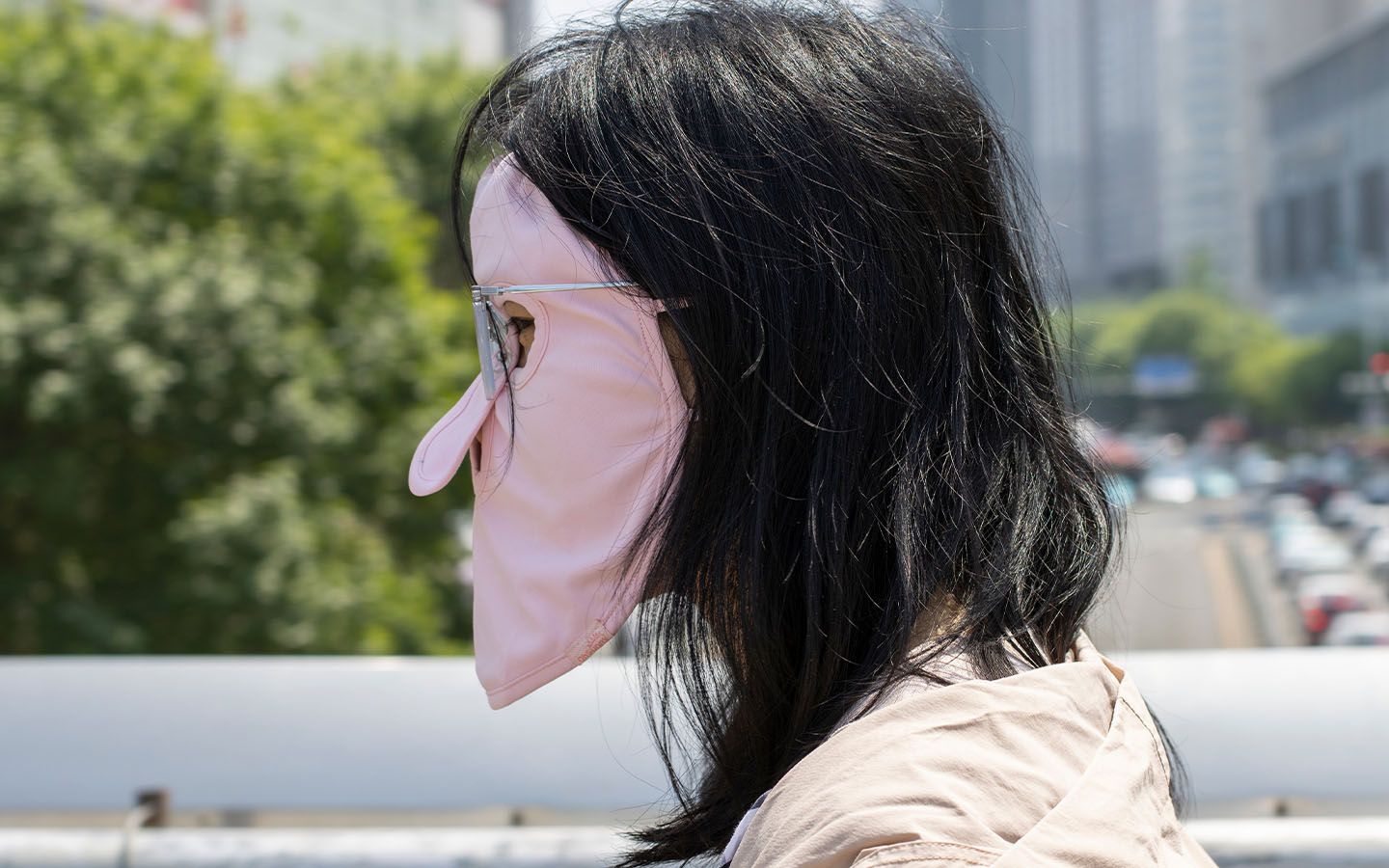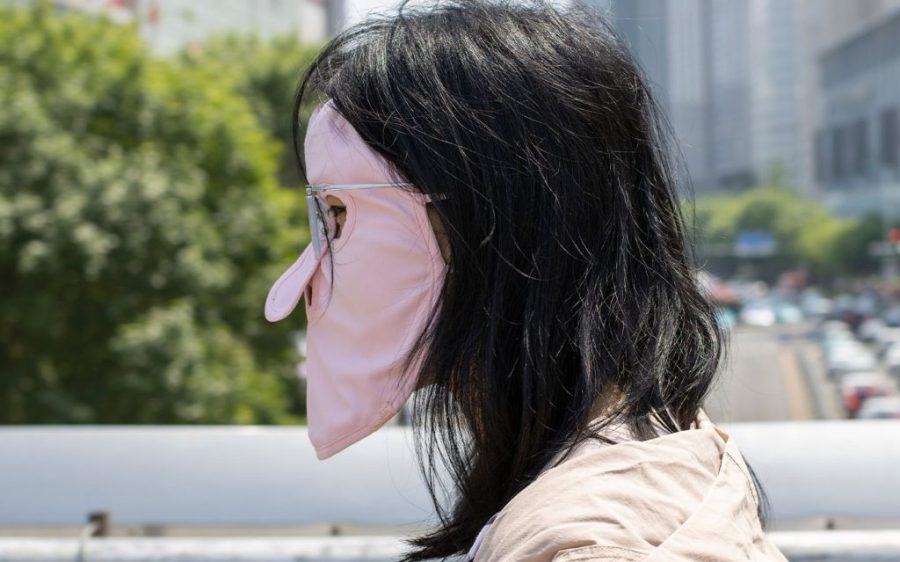To satisfy the male gaze, Chinese women have long had to adhere to stringent beauty standards. While some extreme practices such as foot-binding are thankfully a relic of the past, other traditional ideals such as having pale skin have persisted. The idea that fair skin is beautiful is reflected in the old Chinese proverb “一白遮百醜” (yī bái zhē bǎi chǒu), which can be translated into “a white complexion is enough to conceal a hundred blemishes.”
In an attempt to keep themselves as pale as possible, some Chinese women rely on skin whitening products such as creams, moisturizers, lotions and face masks. It is also not uncommon to see ladies using an umbrella to shield themselves from the sun when outdoors.
[See more: What is the Beijing Bikini?]
Some Chinese women are so afraid of getting a tan that they will resort to wearing a “facekini” (臉基尼, liǎn jī ní). A portmanteau of the words “face” and “bikini,” this spandex face mask is intended to protect the wearer from the sun by covering the entire head, although holes have been left for the eyes, nose and mouth. Picture a cross between Mexico’s famous lucha libre wrestling mask and the bank robber balaclavas from the movie Heat (1995).
Keep reading to find out more about this unique Chinese accessory, its inventor and why it’s attracted so much attention.
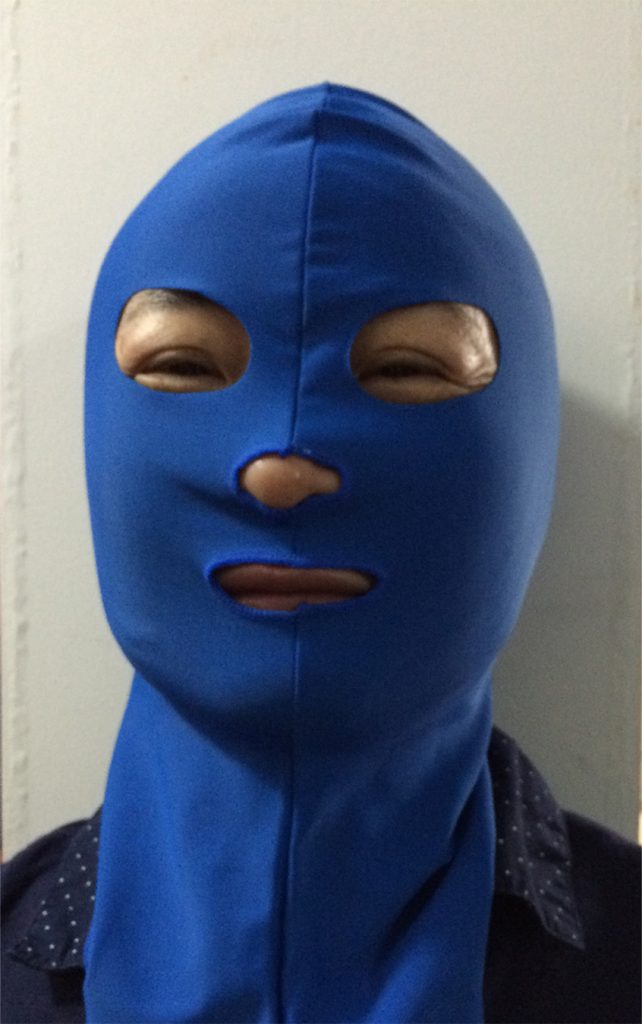
Who came up with the facekini?
The woman behind the facekini is 69-year old Zhang Shifan (張式范) who hails from the coastal Chinese city of Qingdao. In late 2003, the retired accountant began operating a swimwear and swimming equipment store with her husband, who was already involved in swimsuit design and the trading of such products.
Zhang began to develop a swimsuit that covered the entire body after noticing “a lot of customers that were stung by jellyfish,” the Qingdao native told Goldthread in 2019. “So I started selling these really thin wetsuits that cover the body from neck to feet.”
Development of the facekini didn’t start until one regular customer told Zhang in the autumn of 2004 that “what you’ve done is good, but it’s only half-way. The neck and face are exposed, so if a jellyfish stings the face, it will be especially painful.”
[See more: Miu Miu has topped the current list of fashion’s hottest brands]
Other customers expressed similar sentiments, telling the swimwear designer that “the face is more important than the body” and that they worried about their faces either being stung or exposed to the sun.
In response, Zhang set about creating the first generation of facekini, seeking inspiration from ski and diving masks. As the saying goes, the rest was history, with the garment gaining a strong following, especially among middle-aged Chinese women – known in Chinese as 中國大媽 (zhōng guó dà mā).
Why has the facekini attracted so much publicity?
The facekini has attracted domestic and international attention due to its design, which has been described with an array of unflattering adjectives including “weird-looking,” “strange,” “bizarre,” “absurd“ and “ugly.”
The look of the facekini hasn’t been entirely lost on its creator, who relates to Goldthread the story of a man who “saw two people wearing facekinis [at night] and was so scared that he couldn’t even walk.”
[See more: The fashion industry must slash production to meet climate goals, report finds]
Although the face mask has been around in China since 2004, the mask didn’t begin to attract western media attention until 2012. The response among English-language outlets has varied, with some treating it as a curious novelty and others as a bonafide fashion statement. In fact, the masks were featured alongside luxury jewellery in the 2014 “Masking in the Sun” photoshoot for CR Fashion Book, a biannual magazine by former Vogue Paris editor, Carine Roitfeld.
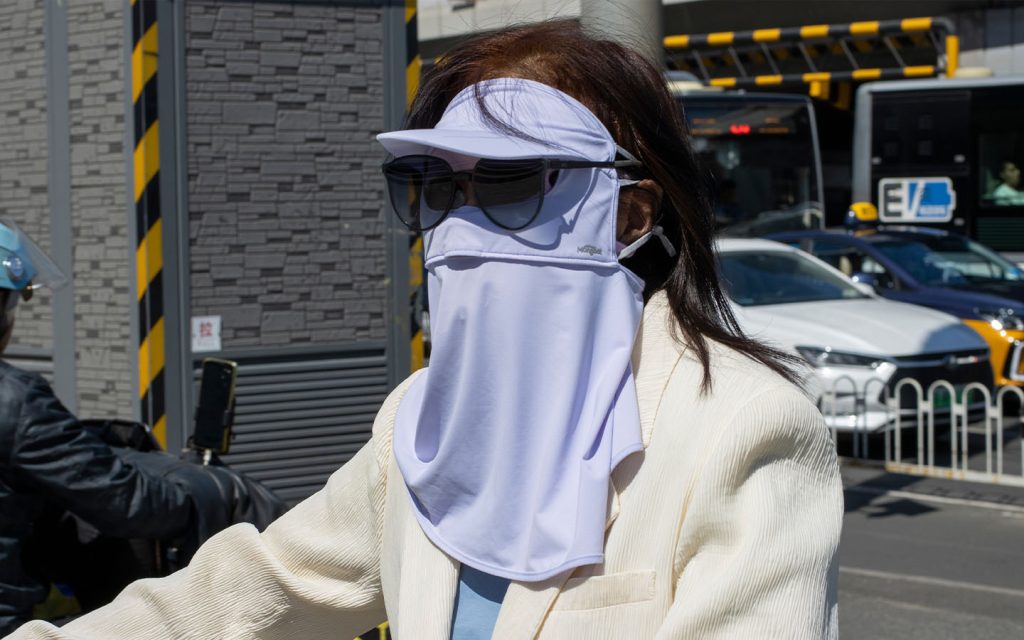
Who came up with the name facekini?
According to Liu Keliang (劉克亮), the husband of facekini’s inventor, the garment was originally called 頭套 (head cover) or 護臉 (face protector) in Chinese. The name facekini, was coined overseas and became popularised after the mask began to attract media attention from outlets such as Reuters and Time magazine in 2012.
Where can I buy a facekini?
The easiest way to pick up a facekini is through an online store such as Taobao, Jingdong or Amazon. There are various brands available, although look for the Sturgeon Dragon (鲟龙) label if you want the ones developed by original inventor Zhang Shifan. Sturgeon Dragon facekinis are relatively cheap, costing as little as 20 yuan, depending on the seller.
What do people think of the facekini?
Reactions to the facekini have been mixed, with one China Daily reader from the US giving an overwhelmingly negative assessment of the masks by describing them as “ugly” garments that should not be worn overseas by the Chinese “unless they want to be mistaken as terrorists.”
Other interviewees offered more nuanced observations. One US reader pointed out that the perceived weirdness of the facekini was due to the different cultural beauty standards and that cultural relativism needs to be taken into account.
[See more: Fast fashion is far more expensive than you thought]
A reader from Canada told China Daily that even though the facekini is “scary,” Chinese women “are right to protect their skin,” which she personally admires for “their flawless porcelain” quality.
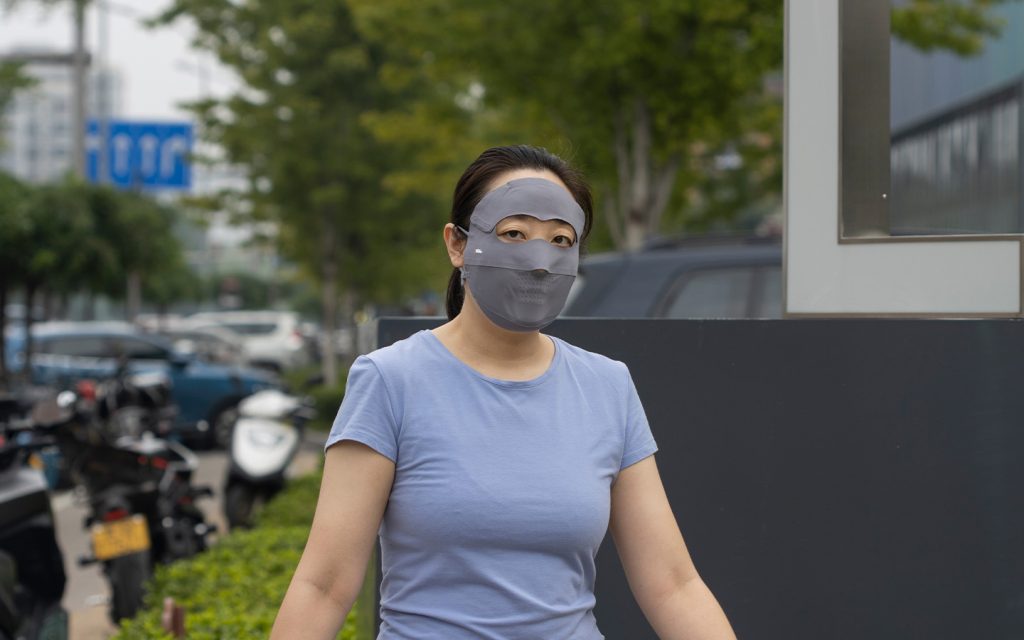
Can the facekini really protect you from the sun?
Facekinis can protect you from the sun, according to Li Tong, a dermatologist with the West China School of Medicine in Sichuan. She told local media that the masks can be more effective than applying sunscreen, using an umbrella or wearing a hat, as “some of the UV rays reflected will still hit the face.”
Despite this, the effectiveness will ultimately depend on the quality of the brand and the type of material used. In China, a product that offers adequate UV protection is required to have an Ultraviolet Protection Factor (UPF) of at least 40 and an Ultraviolet A (UVA) transmission of less than 5 percent. To ensure you are buying a facekini that is up to scratch, make sure you read the labels and certification from the seller.
[See more: Your sunscreen may be making plastic marine pollution worse]
Wearing a facekini all the time may also not necessarily be good for your health. In a state media interview, Xue Ke, a dermatologist with the China-Japan Friendship Hospital, said that overprotection from the sun can result in vitamin D deficiency, which can lead to osteoporosis.
What types of facekini are there?
The official facekinis from Zhang Shifan have gone through a number of iterations over the years. Generation one to three of the garment had only one type of colour and resembled a diving hood that covered a person’s head and neck, but left four holes that exposed the eyes, nose and mouth.
By the fourth generation, Zhang began to experiment with different designs including ones that paid homage to Peking Opera. Generation five would see a major update to the facekini’s dimensions by expanding its coverage to include the chest. Zhang would take this further in the sixth iteration, which covers the entire face and body in a manner not unlike a wetsuit. The Global Times even coined the term “bodkini” in 2019 for this full body variation.
As of 2024, the facekini was in its ninth generation, with Zhang telling reporters that this latest version had “face slimming properties” thanks to its use of silicon strips.
[See more: More than a fifth of the world’s oceans are losing sunlight]
“These strips support and lift up the cheeks, jaw and neck of the users,” Zhang said. “When a user is in the process of exercising, it can prevent their muscles and skin from drooping and tighten the dimensions of the face, achieving a face slimming effect.”
Whether or not this is effective is open to debate, but regardless, Zhang’s designs remain every bit as flamboyant, with some of the models photographed wearing facekinis and bodkinis that resemble snakes and tigers.
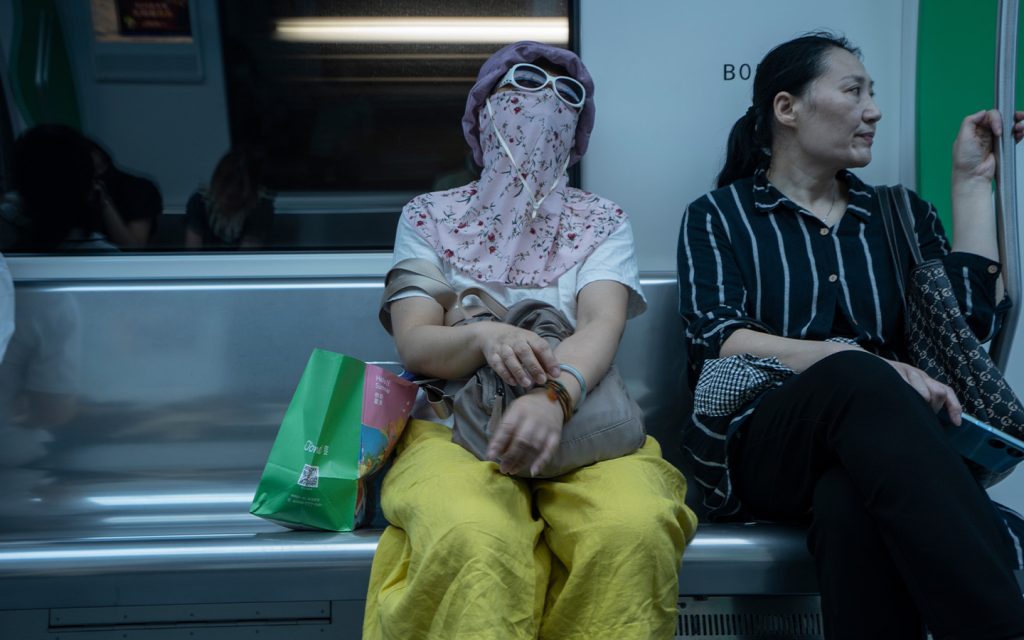
Are facekinis only for women?
While the facekini trend is largely associated with Chinese women who wish to protect their skin from the sun, that hasn’t stopped some brands from selling facekinis that are tailor made for men.
There have also been instances of men wearing the facekini on national television, with one man donning a Monkey King variation of the mask during a 2019 CCTV variety show. Similarly, Huang Bo, Sun Honglei and other Chinese actors were spotted wearing the famous masks for the TV show Go Fighting in 2015.
What are some other similar international variants?
The burkini – a portmanteau of the words burqa and bikini – is one garment that has drawn comparisons with the facekini. Invented by Lebanese-Australian fashion designer, Aheda Zanetti, this swimsuit was initially intended for Muslim women who wished to go swimming without contravening the modest Islamic dress code for women.
Much like the burqua, the burqini conceals the entire body, although it differs from traditional Muslim attire by leaving the face exposed. Despite this, the garment has attracted controversy, especially in France, where certain towns have banned people from wearing it.
[See more: Keep your cool: Six hotel pools in Macao that offer day passes]
Outside of religion, the burqini has become the swimwear of choice for those looking to protect themselves from the sun, with German dermatologist Claus Grabe telling Chinese media that such attire is among the most effective ways to reduce the risk of skin cancer.
Japan’s zentai, which are stretchy suits that cover the entire body and face, also evoke the later variants of the facekini. Zentai suits come in various designs and colours, and sometimes have eye holes. Unlike the burkini, however, they are generally seen as a way to push back against conservative values rather than uphold them.
